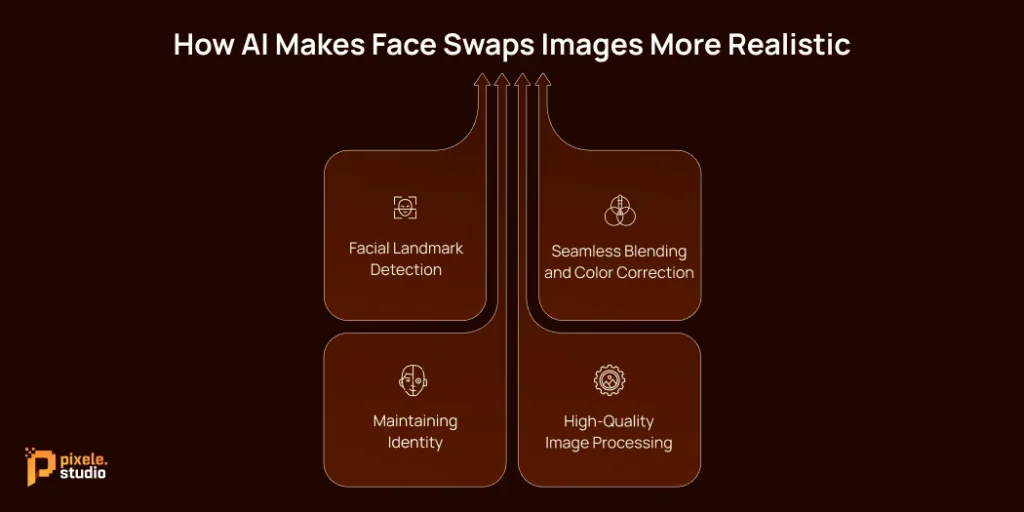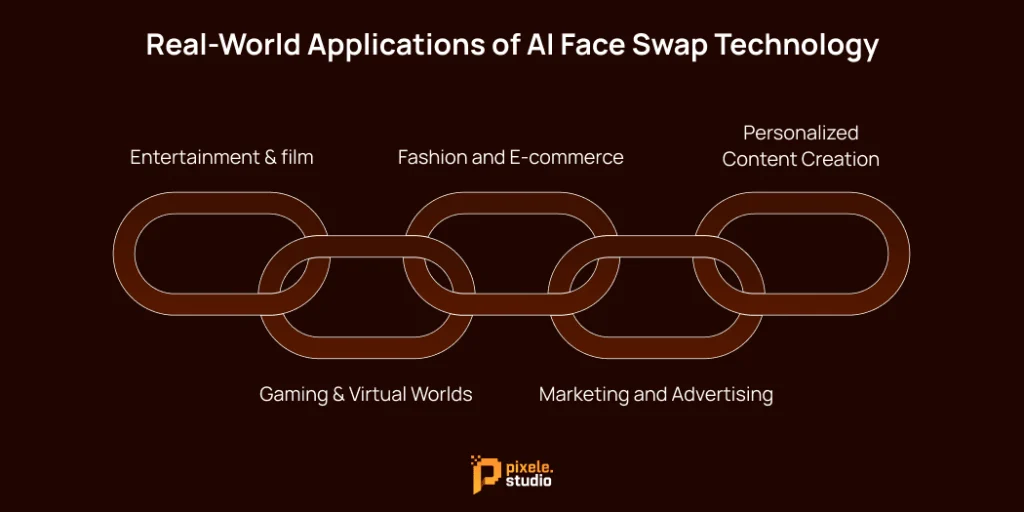Imagine scrolling through your feed and seeing a photo of your face transformed into a movie character’s or a celebrity’s face, perfectly placed in a funny scene. At first, it looks real. But it’s actually created with artificial intelligence (AI).
Face swap images have come a long way. Old edits looked fake and mismatched. Now, AI makes them smooth, natural, and almost impossible to spot.
This change is possible because AI understands facial details. It matches skin tone, lighting, and expressions with amazing accuracy. What once needed expert skills can now be done by anyone in minutes.
In this blog, we’ll explore how AI is making face swap images more realistic than ever, and where people are using it today.
The Evolution of AI in Face Swapping
In the beginning, swapping faces in photos was a difficult and manual job. You need expert skills in photo editing software like Adobe Photoshop.
Artists had to carefully cut out a face, place it on another picture, and then painstakingly blend the colors, skin tones, and angles to make it look somewhat real. Most of the time, you could easily tell it was fake, and it was often more funny than convincing.
Things got a lot better with automated software that could find facial features. These early tools made the process simpler, but they still struggled to make a smooth blend. You could often see the digital “lines” where one face ended and another began, and lighting and perspective often didn’t match.
The real game-changer was the arrival of deep learning, especially something called Generative Adversarial Networks (GANs).
Think of GANs as two computer programs working against each other. One program, the “generator,” creates the face swap images. The other program, the “discriminator,” tries to figure out if these images are real or fake.
This constant back-and-forth makes the generator create more and more realistic images that are hard to tell from real ones. This AI technology automated the hardest parts of the process, making high-quality swaps possible in just seconds.
How AI Makes Face Swaps Images More Realistic

Modern AI image face swap technology works by really understanding human faces. It doesn’t just cut and paste; instead, AI looks closely at a face and rebuilds it. Here’s a simple way to think about how it does this:
Facial Landmark Detection
First, the AI finds important spots on both faces: the one you want to use (source) and the one you’re putting it on (target). It pinpoints many details, like the corners of the eyes, the nose, the jawline, and the lips.
Seamless Blending and Color Correction
Once the face is aligned, the AI gets to work on blending. It adjusts the skin tone, texture, and lighting of the source face to match the target image’s environment. It can even replicate shadows and highlights, making the final image appear as though it were a single, original photograph.
Maintaining Identity
Advanced AI models learn from huge collections of face images. This helps them keep your unique features and identity while placing your face in a new setting. In simple terms, it makes sure you still look like you, just in a different picture.
High-Quality Image Processing
Modern AI systems are great at creating high-resolution images that don’t lose important details. They use smart algorithms to clean up the image, make it clearer, and keep all the fine points of the face, skin texture, and background.
This means the final pictures look great and can be used for professional printing or on screens. The AI also adjusts the new image to match the quality of the original photos.
What is the Differences Between Face Swap Images and Traditional Photo Editing
Both AI and traditional photo editing can change pictures, but they work very differently and give different results. Knowing these differences helps explain why AI is now the top choice for making realistic face swaps.
| Feature | Traditional Photo Editing | AI Face Swap Technology |
|---|---|---|
| Process | Uses AI to detect and replace facial features automatically | Manual selection, cutting, pasting, and blending. |
| Skill Level | High – requires expertise in photo editing software and techniques | Low to Medium – AI handles most of the complex work |
| Time | Time-consuming – can take hours depending on complexity | Can generate high-quality results in seconds or minutes |
| Realism | It can be very realistic if done by an expert, but it depends on skill | Highly realistic – AI ensures accurate facial alignment and lighting |
| Consistency | May vary from image to image depending | Consistent – AI applies the same method every time |
| Cost | It can be expensive if you hire professional editors or use software | Usually affordable – many free image face swap tools are low-cost or free |
| Speed | Slow Process | Fast Process |
Traditional editing is a skill that depends on human talent, while AI face swapping uses technology to do the same thing, often faster and better, with less work.
Real-World Applications of AI Face Swap Technology

Image face swap technology isn’t just for making funny memes or social media marketing. It’s also used in many industries to create realistic visuals.
Entertainment & film
In the film industry, this technology can make actors look younger, seamlessly place an actor’s face onto a stunt double’s body, or even bring back actors who have passed away for new roles.
Gaming & Virtual Worlds
AI-powered face insertion technology is changing gaming and virtual reality. Players can now create avatars that look just like them, making the experience more immersive.
It also allows games to include the player’s face in the story, making it feel more personal and exciting. This technology makes virtual worlds more engaging by creating characters and environments that feel more connected to the user.
Fashion and E-commerce
Online stores can use face swaps to let shoppers see what clothes look like on them before buying. By uploading their photo, a customer can virtually “try on” an outfit, making shopping more personal.
Marketing and Advertising
Brands can use face swaps to make ads feel personal. They can put a customer’s face into an ad, making it more interesting and easier to remember.
Personalized Content Creation
Every day, users mostly use face swaps for fun. They can make custom greeting cards, put themselves into movie scenes, or just try out new looks. There’s no limit to what they can create.
Effortlessly switch faces in any image and create amazing results in seconds.
The Future of AI Face Swap Images
The future of face swapping will likely be more realistic and easier for everyone to use. We can expect AI to get better at tricky situations, like pictures with things in the way, sharp angles, or changing light. Swapping faces in images will get smoother and work better on regular phones and computers.
But this powerful tool also comes with risks. It could be misused to create fake news, spread wrong information, or make harmful content (often called deepfakes).
Because of this, creating strong tools to spot fake content and making rules for its ethical use are just as important as making the technology better. The tech industry is working on ways like “digital watermarking” to tell the difference between real and AI-made content.
Conclusion
AI has changed face swapping from a small trick to something everyone can use to be creative and share messages. With smart AI, these face swap tools can look at faces, rebuild them, and mix them so they look incredibly real—something we couldn’t even imagine before.
You can use AI face swaps for serious things like movies and ads, or just for fun on social media. They give us a new way to play with digital pictures.
As this technology gets better, it will surely bring even more creative ideas. But we also need to use it carefully and responsibly. The way face swapping has grown shows how fast AI is changing our digital world, one picture at a time.
Frequently Asked Questions
AI face swaps rely on deep learning, especially Generative Adversarial Networks (GANs), to analyze facial features and reconstruct faces with matching expressions, skin tone, and lighting for seamless blends.
Pixele Studio is the most realistic face swap app, offering highly natural results in photos.
Mismatched facial angles, lighting, skin tones, and poor alignment can reduce realism. Post-processing, like color correction and blending, is often necessary for flawless results.
Film, advertising, gaming, fashion, and social media all leverage realistic AI face swaps for creative storytelling, personalized marketing, and immersive experiences.